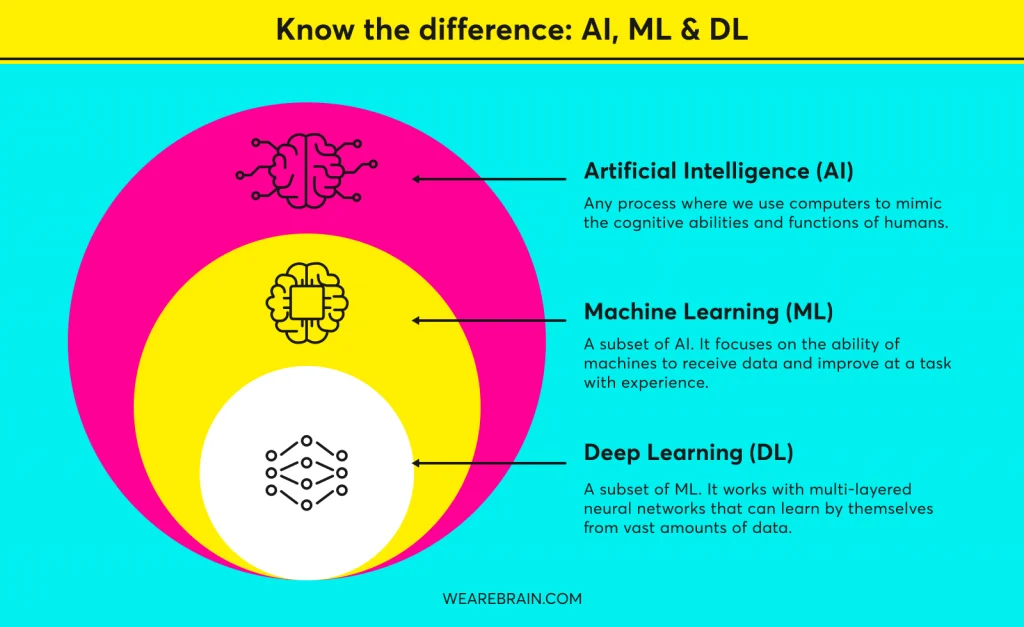Machine learning is transforming how we manage daily activities and complex challenges, improving everything from personal scheduling to business strategies. This guide explores the fundamentals of machine learning, its practical applications across various industries, and its transformative impact on career landscapes.
In the rapidly evolving tech landscape, understanding machine learning is crucial. This dynamic field boosts data analysis capabilities, automates everyday tasks, and opens up new career opportunities. Discover the underlying principles of machine learning and see how it is being innovatively applied across sectors.
Join us as we make the complexities of this advanced technology accessible and engaging for everyone, from students beginning their academic journeys to professionals enhancing their skills.
Understanding machine learning
Machine learning is a dynamic field within artificial intelligence (AI) that allows systems to learn from data and make decisions with minimal human intervention. It is celebrated for its ability to improve automatically through the continuous analysis of data and the use of advanced algorithms.
Goals and applications of machine learning
Machine learning aims to achieve several important goals:
- Classifying data. Identifying patterns and organizing data effectively, such as sorting emails into genuine and spam categories.
- Making predictions. Using historical data to predict future events, such as guessing house prices in different cities.
These methods are employed in diverse areas, significantly impacting fields including language translation, consumer preference analysis, and medical diagnostics.
Theoretical foundations of machine learning
Delving into the foundational theories behind machine learning offers deeper insights into its operations:
- Statistical learning theory. Many machine learning algorithms are based on building statistical models to learn from data. This theory helps in understanding the adjustments that algorithms make.
- Computational learning theory. This area of computer science studies the basic math behind learning algorithms, providing a clearer understanding of how they work and how complex they are.
- Neural networks. Modeled after the human brain, neural networks are critical for deep learning and are crucial in detecting intricate patterns and anomalies in data.
Evolution and impact
Machine learning is continuously advancing, reflecting developments in technology and societal needs:
- Historical context. From its early days, machine learning has progressed from elementary algorithms to worldly systems capable of operating autonomous vehicles and facilitating medical diagnostics.
- Future trends. Currently, the field is experiencing significant advancements in AI ethics, the growth of quantum computing, and the discovery of new market possibilities. These developments have the potential to greatly affect different industries.
Broadening the perspective
Examining machine learning from various angles shows its wider value:
- Interdisciplinary connections. Machine learning collaborates with fields like psychology, to improve understanding of cognitive processes, and philosophy, to address ethical issues. These interdisciplinary efforts are vital in refining AI system development.
- Global impact. Around the world, machine learning is crucial in helping shape economies and solve big problems. For example, in developing countries, it is changing the healthcare and agriculture sectors, which could help overcome issues like poverty and improve health.

Real-world applications of machine learning
Machine learning isn’t just a theoretical study limited to classrooms; it’s a powerful tool revolutionizing industries and academic environments alike by solving real-world problems and improving efficiency. This section highlights where machine learning has had a big impact, giving examples that show its broad capabilities:
Healthcare
In the healthcare industry, machine algorithms are vital for predictive diagnostics, helping doctors prevent severe health issues by analyzing patterns in patient data to predict potential outcomes. These technologies play a key role in early diagnosis and help monitor patient vitals and tailor treatment plans, resulting in better patient outcomes and more efficient healthcare delivery.
Automotive industry
Machine learning leads the way in automotive innovation, especially in creating self-driving cars. These AI systems analyze data from different sensors to make immediate decisions that improve safety and help with navigation. Key functionalities include obstacle detection, route planning, and driver assistance, all contributing to safer and more efficient driving experiences.
Financial services
In finance, advanced algorithms transform how companies approach fraud detection, risk evaluation, and trading. By carefully examining transaction data to identify unusual patterns, these algorithms can detect potential fraud, assess investment risks, and automate trading to improve financial results, even when market conditions are variable.
Entertainment and media
The entertainment and media industries use machine learning to personalize user experiences. Algorithms that analyze viewing habits recommend movies and TV shows on platforms like Netflix, tailored to the individual’s preferences. Similarly, machine learning is used by publishers to adapt content delivery, improving reader engagement and satisfaction.
Education and academic research
In academic settings, machine learning automates and personalizes learning experiences. It can tailor educational content to fit individual student needs based on learning pace and style, improving engagement and effectiveness. Additionally, machine learning helps in research by analyzing vast datasets more efficiently than traditional methods, allowing for quicker hypothesis testing and innovation in scientific research.
Exploring how machine learning functions
Machine learning works through a clear series of steps, each important for building successful AI models:
- Data collection. The first step involves collecting data from various sources, from music recordings and medical records to camera images. For instance, Spotify analyzes music recordings to understand listener preferences and recommend new songs. This raw and unprocessed data forms the foundation for all subsequent machine-learning processes.
- Data preparation. After collection, data must be cleaned and structured to be understandable by computers. This stage corrects errors and organizes the data. Feature engineering, for instance, extracts important attributes that help solve specific problems, similar to how Google Photos identifies and organizes objects and faces.
- Model training. Selecting an appropriate model is crucial, and training begins once a model is chosen. Here, the model autonomously learns from data by recognizing patterns and adapting its parameters. The goal is for the model to autonomously make reliable decisions or predictions. Netflix, for example, uses models to recommend shows based on users’ viewing histories.
- Model optimization. After training, the model is improved to boost its accuracy and usefulness. It’s adjusted or tested in different ways to work better in real-life situations. For example, Tesla regularly updates its Autopilot software to enhance safety and performance.
- Model evaluation. Testing the model with new data it hasn’t experienced during training is critical to assess its performance. This evaluation helps decide how effectively the model can adapt to new situations and challenges. For example, IBM Watson’s capabilities are regularly tested in diverse healthcare diagnostic scenarios to verify its proficiency with various types of patient data.
- Model deployment. The last step involves deploying the model to execute specific tasks, such as recognizing images or predicting trends. Amazon uses machine learning to predict shopping patterns and optimize inventory management. Post-deployment, the model continues to learn and adapt to stay efficient over time.
- Continuous improvement. Machine learning is cyclic, with each round of data collection, preparation, training, and deployment improving the model’s capabilities, seeking consistent performance even with new data.
- The role of data and algorithms. At its core, machine learning relies on data and algorithms: data is the key input, and algorithms use this to generate valuable insights. For example, Google regularly updates its search algorithms to ensure search results are more relevant by analyzing data from user interactions.

Machine learning models
Machine learning models are diverse, each uniquely tailored to learn and solve problems by processing data effectively. Understanding the differences among them is essential for their successful application in AI projects. Below is an exploration of the primary learning models and their operations:
Supervised learning
The most common type, supervised learning, uses models that learn from clearly marked training data. They use these labels to learn how to predict outcomes or classify new, unseen data accurately.
- Common application. Email services use supervised learning to sort incoming messages into “spam” or “non-spam”.
- Example. Face recognition technologies sort pictures of people by learning from a collection of labeled photos.
Unsupervised learning
In contrast, unsupervised learning models work with unlabeled data. They identify patterns and relationships on their own, organizing data into groups with similar features.
- Task example. In business analytics, unsupervised learning might segment customers into different groups based on their buying behaviors without any prior labeling.
Reinforcement learning
This model learns through trial and error, using feedback from its own actions to make decisions that maximize a reward or minimize risk in unpredictable environments.
- Real-world application. Self-driving cars use reinforcement learning to make real-time navigation decisions, such as when to turn or brake to avoid a barrier.
Finding the right algorithm
Selecting an appropriate algorithm is crucial and depends on the specific needs of the project, including the type of data and the desired outcome.
- Predictive modeling. Algorithms like linear regression are used to predict quantitative outcomes, such as predicting stock market trends based on historical data.
Integration and continuous learning
As machine learning technology progresses, combining various models and constantly updating them with new data becomes essential to increase their precision and effectiveness.
- Continuous improvement example. E-commerce platforms dynamically adjust their product recommendations for users by continuously analyzing user behavior and preferences.
Each machine learning model offers unique advantages and can be specially tailored for particular tasks and scenarios. By understanding these models and choosing the right algorithms, developers can build more effective, adaptive AI systems that evolve with their environments.
Career opportunities in machine learning
As machine learning continues to expand its influence across various industries, it opens up a wealth of career opportunities for those prepared with the necessary skills. Below is a detailed table that outlines key roles in the machine learning field, the essential skills required, potential employers, and typical career paths you might take:
| Role | What they do | Skills needed | Where they work | Career path |
| Data scientist | Analyze large sets of data to help companies make decisions; Use machine learning to uncover insights. | • Proficient in programming (Python/R) • Strong in statistics • Experienced with ML methods | • Tech companies • Banks • Healthcare providers • Marketing firms | Start as data analysts, move up to project design and data strategy leadership. |
| Machine learning engineer | Create and manage ML models from design to deployment. | • Excellent programming skills • Deep knowledge of ML algorithms • Software development skills | • Tech companies • Automotive industries • Finance • Public Safety | Begin in entry-level roles, aiming for positions like AI Architect or CTO in startups. |
| AI research scientist | Develop new AI technologies and methodologies. | • PhD in CS or related field • Extensive AI and ML knowledge • Research experience | • Universities • Research labs • Big tech companies | Start in research, advance to leading projects, or head research departments. |
Learning resources and tools
After exploring the diverse applications and functionalities of machine learning, you might be curious about starting your own journey in this dynamic field. Below is a comprehensive list of resources and tools that can assist you in delving deeper, from online courses and textbooks to open-source software and active community forums. These resources are tailored to support learners at all levels, whether you’re just beginning or seeking to expand your existing knowledge.
Online courses
- Coursera – Machine Learning by Andrew Ng. A popular starter course that covers a broad range of fundamental concepts.
- edX – Artificial Intelligence MicroMasters by Columbia University. A series of graduate-level courses designed to advance your career in AI.
- Udacity – AI and Machine Learning Nanodegrees. Project-based learning to build and sharpen your skills in specialized areas of AI.
Textbooks
- “Pattern Recognition and Machine Learning” by Christopher M. Bishop. Provides a comprehensive introduction for advanced undergraduates and graduate students.
- “Machine Learning: A Probabilistic Perspective” by Kevin P. Murphy. This book offers a detailed introduction to the field of machine learning from a probabilistic viewpoint.
Open-source software
- TensorFlow. Developed by Google, this is a powerful library for numerical computation and machine learning.
- Scikit-Learn. A simple and efficient tool for data mining and data analysis built on NumPy, SciPy, and matplotlib. Matplotlib is a library used in Python for creating static, interactive, and animated visualizations.
- PyTorch. An open-source machine learning library from Facebook, widely used for applications such as natural language processing.
Community forums
- Stack Overflow. A vital resource for developers and engineers to ask questions and share insights.
- Reddit r/MachineLearning. An active community for discussing the latest in machine learning techniques, news, and research.
- GitHub. Provides a vast storage of projects where you can collaborate and contribute to real-world applications.
Differences between machine learning and deep learning
Having explored a variety of tools and resources for learning about machine learning, it’s important to understand the differences within the field itself. As we dive deeper into machine learning’s complexities and its applications across various domains, it becomes crucial to differentiate between general machine learning techniques and the specialized subset of deep learning. Both are fundamental to the development of intelligent systems but differ significantly in how they function and the problems they solve.
Understanding the differences
General Machine Learning (ML) uses a broad spectrum of algorithms that operate under direct human guidance. These algorithms are trained with data that has been explicitly labeled by experts, requiring human input to define the labels and features. The systems use these predefined criteria to categorize data or make predictions.
For example:
- Email filtering systems sort messages into “spam” or “non-spam” categories using user-defined features like keywords or the sender’s reputation.
Deep Learning (DL), a focused subset of machine learning, employs complex neural networks to analyze data layers autonomously. This method excels at processing unstructured data such as images and audio, identifying relevant features without needing human-coded instructions or predefined categories.
For example:
- Voice recognition technologies in devices like Siri and Google Assistant process spoken language naturally, without manual programming for each phrase or word.
Practical applications and future directions
Deep learning proves highly effective in scenarios where traditional machine learning might struggle:
- Autonomous vehicles. Deep learning algorithms interpret data from various sensors to make instant navigation decisions, like identifying obstacles or planning routes.
- Healthcare. DL improves the accuracy and speed of interpreting medical images like MRIs, improving diagnostic precision beyond traditional methods.
Integration and advancement in AI
The synergy between machine learning and deep learning is revolutionizing various industries by combining structured, rule-based learning with intuitive, automatic data analysis. This combination is expected to drive significant advancements in AI, making systems smarter and more responsive to real-world scenarios.

Ethical considerations in machine learning
As we dive deeper into machine learning and deep learning, it’s essential to consider the ethical aspects that come with these technologies. Ethical practices are crucial for responsibly developing AI and greatly affect how these technologies are used and viewed around the world. In this section, we’ll explore important ethical issues that are key to building reliable and fair AI systems:
Data privacy
Machine learning relies heavily on large amounts of data to improve and become more precise. Often, this data includes personal information, which can raise privacy concerns. A notable example is Facebook’s use of personal data for targeted advertising, which has led to widespread discussions about privacy rights. It is crucial to understand the implications of using personal data and to develop strong measures to protect individuals’ privacy.
Consent and transparency
Understanding how machine learning algorithms work and how they make decisions is key to building trust and ensuring accountability. For example, the European Union’s General Data Protection Regulation (GDPR) requires that individuals have the right to understand the logic behind decisions made by automated systems that affect them. This is known as the ‘right to explanation’. It’s also vital for developers to get clear support for using someone’s data, especially personal information. This ensures that users are fully knowledgeable and agreeable to how their data is being used.
Bias and fairness
Bias in machine learning models can lead to unfair treatment and discrimination. For example, some image recognition systems have incorrectly identified faces from certain ethnic groups. This shows why it’s important for developers to prevent biases in AI systems. We must ensure that machine learning decisions are fair and do not discriminate to promote fairness.
Impact on employment
The rise of AI and automation is reshaping employment across many industries. Technologies like robotic process automation are expected to change various jobs and sectors. For instance, automation in manufacturing might reduce the need for certain skills and decrease the necessity for human labor in repetitive tasks. Future AI specialists should think about these economic shifts, including the possibility of new jobs in tech-related fields and the need for retraining workers who lose their jobs due to automation.
To explore more about ethical practices in AI development, including detailed discussions on the EU’s AI Act and its implications for innovation and ethics, you can read more in our comprehensive article here.
By proactively engaging with these ethical concerns, the machine learning community can promote the development and implementation of AI technologies that are not only advanced technologically but also socially responsible and ethically sound.

Strengths and limitations of machine learning
As we conclude our detailed exploration of machine learning—from its basic concepts to its varied uses and the ethical issues it raises—it’s important to think about both the broad abilities and the main challenges of this impactful technology. This final section summarizes our discussions by highlighting the key strengths and significant challenges that affect how machine learning is used in different areas.
Strengths
- Scalability of analysis. Machine Learning excels when working with large datasets, as it can automatically detect patterns and make predictions more efficiently than traditional methods. This is especially useful in areas like big data analytics and search engines.
- Adaptability. ML algorithms are naturally designed to continually improve their accuracy by learning from new data, which is essential in dynamic settings such as personalized content recommendations where user preferences evolve over time.
- Automation. ML greatly improves decision-making speed and reduces human error, making it essential in areas like financial trading and healthcare diagnostics where accuracy is critical.
- Efficiency. By using resources more efficiently, ML helps improve overall efficiency in various tasks. This includes better energy management in systems known as smart grids, which help predict the busiest times for energy use and reduce waste by adjusting the supply accordingly.
Limitations
- Overfitting. This happens when a model is too complex, capturing noise instead of the underlying data pattern, which can worsen its performance on new datasets.
- Transparency. The “black box” nature of many ML models presents challenges in sectors like healthcare and banking where clear audit trails are required. This lack of transparency can undermine trust and obstruct accountability.
- Bias. If biases in training data are not addressed, they can lead to unfair outcomes in automated decisions, which is especially concerning in areas like hiring and borrowing approvals.
- Scalability of implementation. Although they handle large datasets well, expanding ML models to bigger or more practical applications can pose significant challenges due to high computing needs and costs, which may not be practical for all organizations.
While machine learning offers many advantages that can transform industries, it also encounters significant limitations that could hinder its broader application. Looking ahead, the machine learning community must capitalize on these strengths while also overcoming the limitations with creative solutions and ethical practices. By maintaining this balanced focus, we can ensure that machine learning achieves its full potential as a fundamental technology, advancing progress responsibly and inclusively.
Conclusion
| Machine learning is at the forefront of a technological revolution, offering new efficiencies and innovations across numerous industries. This journey has shown the critical importance of balancing innovative potential with ethical responsibility to ensure benefits for all sectors of society. As we look to the future, our collective challenge is to guide this development carefully, ensuring technological advancements are achieved responsibly and inclusively. Are you ready to join this journey and help unlock the full potential of machine learning in a way that keeps our commitment to fairness and progress? Let’s innovate responsibly, ensuring that every step we take supports fair and ethical advancements in technology. |
